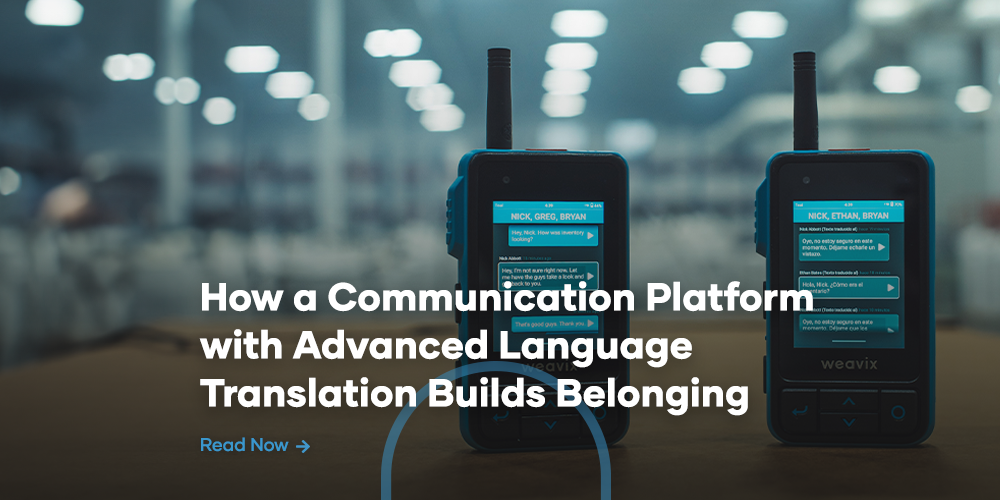Are phones replacing push-to-talk radios in industrial workplaces? Unfortunately, some industry experts like to think so.
Recently, there has been a push for frontline workers to simply download and use push-to-talk applications on their mobile devices, rather than continuing to use traditional radios. While this seems like a fast and simple way to save your enterprise money and still give workers those same benefits, phones aren’t the perfect communication solution for frontline workers.
For industries like manufacturing, construction, hospitality, and oil and gas, using phones presents more unnecessary risks to the company and workers themselves than if they continued using push-to-talk radios.
1. You Have Less Control and Access to Your Data
From user agreements and a phone’s operating system (OS) regulations, smartphone manufacturers and app developers create hurdles for you to access and use your data to your benefit. Their user agreement policies and federal regulations outline what information they can collect, how they store it, and how they can use your personal data.
Location, browsing, and communication data are some examples of what smart devices capture.
Location tracking information is highly sought after by analysts and business leaders but is heavily regulated in some countries. Mobile device management (MDM) software is often administered on work phones to add an extra level of protection at the expense of browsing data. Push-to-talk apps and rugged phones also lose communication data when a user is removed or leaves the company.
Today’s businesses run on data, and enterprise leaders want to analyze as much data as possible to ensure maximum efficiency and outputs. So, doesn’t it make sense that you access and benefit from your data yourself? Instead of harboring your data and using it against you, weavix® processes it and draws insights you can use to benefit your frontline productivity.
2. They’re Not Suitable for the Work Environment
Push-to-talk radios have been the top choice for frontline communication since they were developed in the early 1900s. There’s a reason for that. These radios are often ruggedly designed, work with gloves, and go through extensive testing for their durability and ability to continue operating after suffering extensive damage common for frontline workplaces.
There are many design limitations phones have that make them inferior to push-to-talk radios for frontline communication. They are difficult, and sometimes impossible, to use them with gloves, which is important for the typical frontline worker. In remote or highly industrial work areas, phone coverage is much less reliable. They also aren’t designed and tested to endure the same extent of damage that push-to-talk radios can.
Manufacturers have developed ruggedized phones and phone cases to alleviate some of these design flaws. However, these modifications don’t address all the operating issues phones bring to frontline workers, like being able to operate while wearing gloves or unreliable coverage in certain areas.
Compared to phones, even the ruggedized ones, push-to-talk radios are more suitable for frontline workers. Workers can use them effectively with gloves on, they offer more reliable communication in remote and industrial workplaces, and they are specifically designed and battle-tested to endure common damages frontline workers experience.
3. High Upfront and Maintenance Costs
Just like with radios, mobile phones have high upfront and maintenance costs. Buying a push-to-talk radio or smartphone can cost an average of $1200 or higher per device.
For your frontline communication efforts to make a meaningful impact, reducing the number of communication gaps should be your first priority. However, the high device costs keep enterprises from equipping every worker with a device and closing those communication gaps, whether it be with a phone or a push-to-talk radio.
weavix® takes a different approach to avoid these high upfront costs. Every worker is given a walt® smart radio that comes included as a managed service. Replacements and repairs are also included with every plan at no additional cost. This model alleviates the financial burden smartphone manufacturers and traditional radio providers impose on enterprises.
4. They Add to Communication Barriers in the Workplace
Using phones instead of a complete frontline communication platform contributes to the communication barriers that already exist on the frontline. Smartphones can’t help you overcome language differences, coverage gaps, or the separation between the frontline workforce and their office counterparts at scale. But not every push-to-talk radio can either.
Enterprises are noticing that they benefit more from a platform-based solution, rather than a device-centric approach to overcoming communication barriers.
With a platform like weavix®, all communications happening on the frontline can come together. Capabilities such as language translation, dictation, archived communications data, and the ability to communicate between a radio, app, or web console directly address common communication struggles frontline workers face.
Together, these capabilities give enterprises the opportunity to begin dismantling the communication barriers impacting the quality and effectiveness of the frontline’s performance.
5. They Create Safety and Security Risks
Regardless of the security measures in place by the phone manufacturer and its operating system, smartphones are more prone to hacking and data compromises than push-to-talk radios. Downloading third-party apps containing malware is the most common security risk for mobile phones, which can leave your business and your data more vulnerable to cyber-attacks.
This is especially concerning and adds more complexity to locating and resolving any data breaches if mobile phones are your workforce's primary method of communication.
Push-to-talk radios have much fewer points of vulnerability compared to phones, ensuring more protection from cyber threats. They oftentimes adhere to stricter and more consistent security protocols than third-party apps. weavix® follows all industry best practices to monitor for threats, authenticate the identity of our users, and ensure all communications and data are secure at rest and in transit.
6. Workers Don’t Want to Use their Personal Devices
Many enterprises mandate that workers use their personal mobile phones in lieu of the company purchasing them all a mobile phone. While this practice is most common in an office setting and can help curb the high upfront costs as discussed earlier, it’s not encouraged for frontline workers.
Requiring workers to use their personal devices can spark concerns over personal privacy, data usage, and more. If frontline workers are also members of a union, there may be a clause in their union agreement barring the employer from enforcing this policy as well.
There’s also the issue of if frontline workers will actually use their personal devices for work. It’s not uncommon for people to silence their notifications or get distracted by other apps and messages unrelated to work. Both examples are avoidable risks when personal devices aren’t looked at as a viable solution for frontline communications.
7. They Lack Certain Safety Certifications
OSHA assigns certain work environments, especially those handling hazardous materials, a safety rating. This designates what materials are present in the area and what safety precautions all must abide by. This rating also determines what tools and devices OSHA allows workers to use to avoid serious injuries and, if not followed, they can impose fines and strict penalties.
For push-to-talk radios, these certifications designate that the tools have either met or exceeded OSHA’s strict requirements for safe use in these specific areas. The walt® smart radio holds a UL certification, deeming it intrinsically safe, and is a certified Class 1 Div. 2 device.
Some rugged phones hold similar safety certifications and meet these OSHA standards. However, enterprises still face financial barriers when trying to connect every worker. Regular smartphones don’t hold these certifications, nor do they have an incentive to achieve them. Due to the potentially serious safety risk, uncertified phones and other devices are strictly prohibited from entering these areas, let alone being used by workers.
What’s the Best Communication Device for Frontline Workers?
Since smartphones aren’t the best option for frontline communication, should workers stick with their traditional push-to-talk radios? Not exactly.
Push-to-talk radios are a better fit for frontline workers than phones, but they have had minimal innovations since being introduced.
The walt® smart radio gives workers the durability and effectiveness of a push-to-talk radio with the technological advancements industry experts have come to expect with smartphones. Specifically designed to grant advanced communication and safety capabilities to frontline workers, regardless of where they work, every walt® is purpose-built to bring the best of push-to-talk radios and smartphones together to advance workers.
Today’s workforce needs more technology and more features than traditional push-to-talk radios provide to stay competitive and continue yielding results for their workplace. But phones and apps aren’t the solution – a platform is. Schedule a demo today to see why weavix® is the preferred communication platform for frontline workers.
Subscribe
Don’t miss out on industry news and information. Subscribe to interweave, the official weavix™ blog today.





